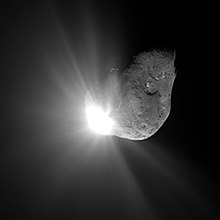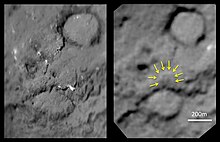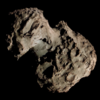astro.wikisort.org - Comet
Tempel 1 (official designation: 9P/Tempel) is a periodic Jupiter-family comet discovered by Wilhelm Tempel in 1867. It completes an orbit of the Sun every 5.5 years. Tempel 1 was the target of the Deep Impact space mission, which photographed a deliberate high-speed impact upon the comet in 2005. It was re-visited by the Stardust spacecraft on February 14, 2011 and came back to perihelion in August 2016.
 Composite of images of nucleus obtained by the Deep Impact impactor | |
| Discovery | |
|---|---|
| Discovered by | Wilhelm Tempel |
| Discovery date | April 3, 1867 |
| Orbital characteristics A | |
| Epoch | July 31, 2016 |
| Aphelion | 4.748 AU |
| Perihelion | 1.542 AU[1] |
| Semi-major axis | 3.145 AU |
| Eccentricity | 0.5096 |
| Orbital period | 5.58 years (2,038 days) |
| Inclination | 10.474° |
| Earth MOID | 0.52 AU (78 million km) |
| Dimensions | 7.6 km × 4.9 km (4.7 mi × 3.0 mi)[2][3] |
| Rotation period | 40.7 hours[2] |
| Last perihelion | March 4, 2022[1] August 2, 2016[1] |
| Next perihelion | 2028-Feb-12[4] |
Discovery and orbital history
This section needs additional citations for verification. (August 2022) |
Tempel 1 was discovered on April 3, 1867, by Wilhelm Tempel, who was working at Marseille. At the time of discovery, it approached perihelion once every 5.68 years (designations 9P/1867 G1 and 1867 II).[5][6] It was subsequently observed in 1873 (9P/1873 G1, 1873 I, 1873a) and in 1879 (1879 III, 1879b).[7]
Photographic attempts during 1898 and 1905 failed to recover the comet, and astronomers surmised that it had disintegrated, when in reality, its orbit had changed. Tempel 1's orbit occasionally brings it sufficiently close to Jupiter to be altered, with a consequent change in the comet's orbital period.[citation needed] This occurred in 1881 (closest approach to Jupiter of 0.55 AU), lengthening the orbital period to 6.5 years. Perihelion also changed, increasing by 50 million kilometres, rendering the comet far less visible from Earth.[citation needed]

Tempel 1 was rediscovered in 1967 (as 9P/1967 L1, 1966 VII), after British astronomer Brian G. Marsden performed precise calculations of the comet's orbit that took into account Jupiter's perturbations. Marsden found that further close approaches to Jupiter in 1941 (0.41 AU) and 1953 (0.77 AU) had decreased both the perihelion distance and the orbital period to values smaller than when the comet was initially discovered (5.84 and 5.55 years, respectively).[citation needed] These approaches moved Tempel 1 into its present libration around the 1:2 resonance with Jupiter. Despite an unfavorable 1967 return, Elizabeth Roemer of the Catalina Observatory took several photographs.[citation needed] Initial inspection revealed nothing, but in late 1968 she found a June 8, 1967 exposure (Tempel 1 had passed perihelion in January) that held the image of an 18th magnitude diffuse object very close to where Marsden had predicted the comet to be. At least two images are required for orbit computation, so the next return had to be awaited.
Roemer and L. M. Vaughn recovered the comet on January 11, 1972, from Steward Observatory (9P/1972 A1, 1972 V, 1972a).[citation needed] The comet became widely observed, reached a maximum brightness of magnitude 11 during May, and was last seen on July 10. Since that time the comet has been seen at every apparition, in 1978 (1978 II, 1977i), 1983 (1983 XI, 1982j), 1989 (1989 I, 1987e1), 1994 (1994 XIUX, 1993c), 2000 and 2005. Its orbital period is 5.515 years.[citation needed]
Physical characteristics

Tempel 1 is not a bright comet; its brightest apparent magnitude since discovery has been 11, far below naked-eye visibility. Its nucleus measures 7.6 km × 4.9 km (4.7 mi × 3.0 mi).[2][3] Measurements taken by the Hubble Space Telescope in visible light and the Spitzer Space Telescope in infrared light suggest a low albedo of only 4%.[8] A two-day rotation rate was also determined.[9]
Exploration
Deep Impact space mission

Deep Impact 1 Tempel 1 Earth 103P/Hartley

On 4 July 2005 at 05:52 UTC (01:52 EDT), Tempel 1 was deliberately struck by one component of the NASA Deep Impact probe, one day before perihelion. The impact was photographed by the other component of the probe, which recorded a bright spray from the impact site. The impact was also observed by earthbound and space telescopes, which recorded a brightening of several magnitudes.
The crater that formed was not visible to Deep Impact due to the cloud of dust raised by the impact, but was estimated to be between 100 and 250 meters in diameter[10] and 30 meters deep. The probe's spectrometer instrument detected dust particles finer than human hair, and discovered the presence of silicates, carbonates, smectite, metal sulfides (such as fool's gold), amorphous carbon and polycyclic aromatic hydrocarbons. Water ice was detected in the ejecta.[11] The water ice came from 1 meter below the surface crust (the devolatized layer around the nucleus).[11]
NEXT mission


Stardust · 81P/Wild · Earth · 5535 Annefrank · Tempel 1
In part because the crater formed during the Deep Impact collision could not be imaged during the initial flyby,[10] on 3 July 2007, NASA approved the New Exploration of Tempel 1 (or NExT) mission. The low-cost mission utilized the already existing Stardust spacecraft, which had studied Comet Wild 2 in 2004. Stardust was placed into a new orbit so that it approached Tempel 1. It passed at a distance of approximately 181 km (112 mi) on February 15, 2011, 04:42 UTC.[12] This was the first time that a comet was visited twice.
On February 15, NASA scientists identified the crater formed by Deep Impact in images from Stardust. The crater is estimated to be 150 m (490 ft) in diameter, and has a bright mound in the center likely created when material from the impact fell back into the crater.[13] Energy of impactor According to NASA "The impactor delivers 19 Gigajoules (that's 4.8 tons of TNT) of kinetic energy to excavate the crater. This kinetic energy is generated by the combination of the mass of the impactor (370 kg; 816 lbs) and its velocity when it impacts (~10.2 km/s)". According to NASA, "The energy from the impact will excavate a crater approximately 100m wide and 28m deep".[14]
The geometry of the flyby allowed investigators to obtain considerably more three-dimensional information about the nucleus from stereo pairs of images than during Deep Impact's encounter.[15] Scientists were able to quickly spot locations where an elevated flow-like formation of icy material on the comet's surface receded due to sublimation between encounters.[15]
Close approaches
Comets are in unstable orbits that evolve over time due to perturbations and outgassing. Tempel 1 passed within 0.04 AU – or 5.9 million km (3.7 million mi) – of the dwarf planet Ceres on November 11, 2011.[16] Then, as a Jupiter-family comet, it will spend years interacting with the giant planet Jupiter, finally passing within 0.02 AU – or 3.0 million km (1.9 million mi) – of Mars on October 17, 2183.[16]
Gallery
- Tempel 1 from the Stardust spacecraft in 2011
- Comparison of Deep Impact and Stardust photos of a smooth elevated feature on the surface of the nucleus showing recession of icy cliffs at the margins.
References
- MPC
- "JPL Small-Body Database Browser: 9P/Tempel 1" (2009-09-23 last obs). Retrieved 2008-12-16.
- "Comet 9P/Tempel 1". The Planetary Society. Retrieved 2008-12-16.
- "Horizons Batch for 9P/Tempel 1 (90000191) on 2028-Feb-12" (Perihelion occurs when rdot flips from negative to positive). JPL Horizons. Retrieved 2022-06-15. (JPL#K223/6 Soln.date: 2022-Jun-08)
- "In Depth | 9P/Tempel 1". NASA Solar System Exploration. Retrieved 2022-08-04.
- "Tempel 1: Biography of a comet". www.esa.int. Retrieved 2022-08-04.
- Rao, Joe (2005-06-03). "The History of Tempel 1, the 'Deep Impact' Target". Space.com. Retrieved 2022-08-04.
- "Deep Impact – Exploring the Interior of a Comet" (PDF).
- "Space Telescopes Sharpen View of Comet for UM-Led Deep Impact". www.newswise.com. Retrieved 2018-01-10.
- Lakdawalla, Emily (2011-01-19). "Stardust prepares for first second look at a comet: Tempel 1 on February 14". Planetary Society blog. The Planetary Society. Retrieved 2011-02-19.
- Sunshine, Jessica M.; Groussin, O.; Schultz, P. H.; A'Hearn, M. F.; Feaga, L. M.; Farnham, T. L.; Klaasen, K. P. (2007). "The distribution of water ice in the interior of Comet Tempel 1" (PDF). Icarus. 190 (2): 284–294. Bibcode:2007Icar..190..284S. doi:10.1016/j.icarus.2007.04.024.
- Able, D. C. (2011-02-14). "NASA's Stardust Spacecraft Completes Comet Flyby". Stardust-Next Mission. JPL. Archived from the original on 2011-02-18. Retrieved 2011-02-16.
- Tony Greicius (15 February 2011). "Tempel 1 Impact Site". NASA. Retrieved 16 February 2011.
- "The Deep Impact Spacecraft". NASA. 6 June 2013.
- Lakdawalla, Emily (2011-02-16). "Some early scientific impressions of Stardust's Tempel 1 flyby". The Planetary Society Blog. The Planetary Society. Retrieved 2011-02-16.
- "JPL Close-Approach Data: 9P/Tempel 1" (2008-10-25 last obs). Retrieved 2009-05-06.
Further reading
- A'Hearn, M. F; et al. (2005). "Deep Impact: Excavating comet Tempel 1". Science. 310 (5746): 258–264. Bibcode:2005Sci...310..258A. doi:10.1126/science.1118923. PMID 16150978. S2CID 6244382.
External links
- Space.com - Deep Impact
- NASA - Deep Impact
- NASA - Stardust-NExT*
- Tempel 1 natural/contrast-enhanced
- Four views of Tempel 1
На других языках
[de] 9P/Tempel 1
9P/Tempel 1 ist ein kurzperiodischer Komet, der im Sommer 2005 durch die NASA-Raumsonde Deep Impact untersucht wurde.- [en] Tempel 1
[es] 9P/Tempel 1
9P/Tempel 1 o cometa Tempel 1 es un cometa periódico. Fue descubierto el 3 de abril de 1867 por Wilhelm Tempel, un astrónomo que trabajaba en Marsella. Cuando fue descubierto, el cometa alcanzaba su perihelio una vez cada 5,68 años. Se volvió a observar en 1873 y 1879. Sin embargo, la órbita de Tempel 1 se acerca en ocasiones a Júpiter, hecho que provoca un cambio en su periodo orbital. Este evento ocurrió en 1881, alargando el periodo orbital a 6,5 años. El perihelio también cambió, aumentándose en 50 millones de kilómetros, dejando al cometa mucho menos visible desde la Tierra. Como resultado, los astrónomos perdieron la pista al cometa y supusieron que se había desintegrado. No fue hasta los años 60 cuando el astrónomo estadounidense Brian G. Marsden redescubrió Tempel 1, al realizar cálculos precisos de la órbita del cometa, teniendo en cuenta perturbaciones en Júpiter. Su período orbital actual equivale a 5,5 años.[ru] 9P/Темпеля
Комета Темпеля 1 (9P/Tempel) — короткопериодическая комета из семейства Юпитера, которая была открыта 3 апреля 1867 года немецким астрономом Эрнстом Темпелем в Марсельской обсерватории, когда комета медленно двигалась по созвездию Весов. Она была описана как слабый диффузный объект, с диаметром комы в 5 ' угловых минут. Комета интересна тем, что стала объектом исследования сразу двух космических аппаратов: сначала, для изучения состав ядра, на комету был сброшен металлический ударник в рамках миссии Дип Импакт, а затем аппарат Стардаст с пролётной траектории изучил последствия столкновения. Комета обладает довольно коротким периодом обращения вокруг Солнца — чуть менее 5,6 года.Другой контент может иметь иную лицензию. Перед использованием материалов сайта WikiSort.org внимательно изучите правила лицензирования конкретных элементов наполнения сайта.
WikiSort.org - проект по пересортировке и дополнению контента Википедии



